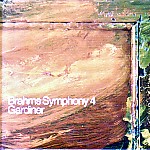John Eliot Gardiner’s Brahms is the musical equivalent of a gluten-free diet. It will keep you alive if you’re deathly allergic to wheat, but if you’re not, why on earth would anyone bother with it? Gardiner makes the usual obeisance to period-performance orthodoxy: Brahms preferred a smallish orchestra (false) and valveless horns (questionable). Gardiner claims to take note of the Meiningen Court Orchestra performance tradition, but then, why so often that dead, vibratoless string sound? The very source Gardiner cites as evidence of that tradition, Walter Blume’s typescript of conductor Fritz Steinbach’s performance notes, reveals that a warm, basic vibrato timbre was standard at Meiningen.
Even if we accept that anything Gardiner does is in fact “authentic”, this does not excuse his personal interpretive lapses: the hectic scramble of a third movement, or his lumpish concluding passacaglia with extremes of tempo purchased at the expense of tension and continuity. Nor does the distribution of strings (12/9/8/7/5) do justice to Brahms’ bass lines–or Beethoven’s for that matter. This Coriolan Overture is fast, but so lacking in rage, in passion. The tinny sound of Gardiner’s band is more appropriate to Alvin and the Chipmunks than to Beethoven or Brahms.
The choral numbers give the Monteverdi Choir something useful to do, but the fact that Brahms himself conducted a bit of Gabrieli and Schütz, and got the passacaglia theme of the symphony’s finale from Bach’s Cantata No. 150, hardly justifies putting them all together on the same program. The result is less an artistic experience than a museum exhibit, or academic exercise of some kind. It’s ironic that this ossification of a once living performance tradition masquerades as authenticity. Dry sonics offer plenty of clarity but make the orchestra sound even more gaunt. Nobody needs this.
































